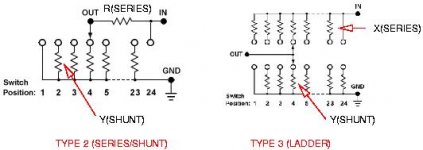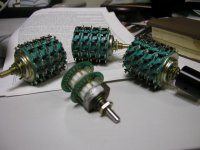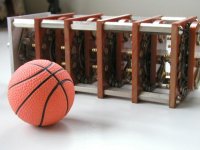Post Preview:
Hi. I'm picking this up from Harry Haller's 'passive preamp' thread, from which I finally understood how a shunt volume works. I'm doing a passive preamp and I have a 10k linear pot. Will this work for a shunt setup? If so, what resistor value should I use? Is the 'Fake Law' arrangement mandatory for a linear pot? If this pot is really unsuitable, what are 'ideal' vlaues for the pot and resisitor? I'm talking pretty general nominal values, because I'm not at a super hi level of fi right now, and I have no idea of the impedance etc. properties of things like my my interconnects. What I do know: My source (CD) line out is 2v, (I don't know it's output impedance or even what this really means other than it may come into play...) My amps (2 monos) are 500mv input sensitive and 100k input impedance.
TIA
Peace and Music
Sanaka
Hi. I'm picking this up from Harry Haller's 'passive preamp' thread, from which I finally understood how a shunt volume works. I'm doing a passive preamp and I have a 10k linear pot. Will this work for a shunt setup? If so, what resistor value should I use? Is the 'Fake Law' arrangement mandatory for a linear pot? If this pot is really unsuitable, what are 'ideal' vlaues for the pot and resisitor? I'm talking pretty general nominal values, because I'm not at a super hi level of fi right now, and I have no idea of the impedance etc. properties of things like my my interconnects. What I do know: My source (CD) line out is 2v, (I don't know it's output impedance or even what this really means other than it may come into play...) My amps (2 monos) are 500mv input sensitive and 100k input impedance.
TIA
Peace and Music
Sanaka
Calculating the values for stepped attenuators
hi
i would highly recommend a DIY stepped attenuator (for example using a 20-position 2 or 4 pole switch). i have attached below simple qbasic code to calculate the resistance values for the three canonical types of attenuators:
TYPE 1: POTENTIOMETER REPLACEMENT
(worst of the 3 types, because there are the most number of solder joints and resistors in the signal path)
A=0
B=0
N=0
PRINT "Number of switch positions"
INPUT S
PRINT "Step Size (dB)"
INPUT D
PRINT "Output (Load) resistance"
INPUT L
PRINT "Input resistance"
INPUT R
DO UNTIL N=S-1
Y=((R-L/10^(-A/20)) + SQR((L/10^(-A/20)-R)^2 + 4*R*L))/2
C=R-Y-B
PRINT A;"dB ";C;"ohms"
B=B+C
A=A+D
N=N+1
LOOP
PRINT A;"dB "; R-B;"ohms"
TYPE 2: SERIES-SHUNT type, a good approximation to type 3, since it only has 2 resistors in the signal path. However, the input resistance is not constant, so the source must be current-capable.
A=0
B=0
N=0
PRINT "Number of switch positions"
INPUT S
PRINT "Step Size (dB)"
INPUT D
PRINT "Output (Load) resistance"
INPUT L
PRINT "Input (SERIES) resistance"
INPUT R
DO UNTIL N=S-1
A=A+D
C=(R*10^(-A/20))/(1-10^(-A/20))
Y=1/(1/C-1/L)
PRINT A;"dB SHUNT=";Y;"ohms"
N=N+1
LOOP
PRINT "SERIES RESISTANCE IS:"; R; "ohms"
TYPE 3: TRUE LADDER. BEST of the 3, each position involves two separate resistors. requires a 6 pole switch for stereo, and a lot of well matched resistors and soldering!
A=0
B=0
N=0
PRINT "Number of switch positions"
INPUT S
PRINT "Step Size (dB)"
INPUT D
PRINT "Output (Load) resistance"
INPUT L
PRINT "Input resistance"
INPUT R
DO UNTIL N=S
Y=((R-L/10^(-A/20)) + SQR((L/10^(-A/20)-R)^2 + 4*R*L))/2
X=R-Y
PRINT A;"dB ";Y; "ohms(to GND) ";X;"ohms(to Signal)"
A=A+D
N=N+1
LOOP
i recently built a stereo attenuator of type 2 using an excellent JBT 19 position 2 pole switch from leeds electronics (www.leedselect.com, surplus switch for $5), with very satisfactory results. I really would not recommend type 1, since you still end up needing a 2 pole switch, and the number of resistors/solder joints in the signal path adds up fast!
hope this helps!
-p
(ps: note on the "Load resistance" above: it is important to use the actual input resistance of your following stage here: for SS gear, this would be the input impedance of the amplifier, for tube gear, i use the grid leak resistor attached to the input(driver) tube. Many potentiometer-type attenuators rely on the shunt-to-ground resistance of the potentiometer itself, which doesn't make sense to me!)
hi
i would highly recommend a DIY stepped attenuator (for example using a 20-position 2 or 4 pole switch). i have attached below simple qbasic code to calculate the resistance values for the three canonical types of attenuators:
TYPE 1: POTENTIOMETER REPLACEMENT
(worst of the 3 types, because there are the most number of solder joints and resistors in the signal path)
A=0
B=0
N=0
PRINT "Number of switch positions"
INPUT S
PRINT "Step Size (dB)"
INPUT D
PRINT "Output (Load) resistance"
INPUT L
PRINT "Input resistance"
INPUT R
DO UNTIL N=S-1
Y=((R-L/10^(-A/20)) + SQR((L/10^(-A/20)-R)^2 + 4*R*L))/2
C=R-Y-B
PRINT A;"dB ";C;"ohms"
B=B+C
A=A+D
N=N+1
LOOP
PRINT A;"dB "; R-B;"ohms"
TYPE 2: SERIES-SHUNT type, a good approximation to type 3, since it only has 2 resistors in the signal path. However, the input resistance is not constant, so the source must be current-capable.
A=0
B=0
N=0
PRINT "Number of switch positions"
INPUT S
PRINT "Step Size (dB)"
INPUT D
PRINT "Output (Load) resistance"
INPUT L
PRINT "Input (SERIES) resistance"
INPUT R
DO UNTIL N=S-1
A=A+D
C=(R*10^(-A/20))/(1-10^(-A/20))
Y=1/(1/C-1/L)
PRINT A;"dB SHUNT=";Y;"ohms"
N=N+1
LOOP
PRINT "SERIES RESISTANCE IS:"; R; "ohms"
TYPE 3: TRUE LADDER. BEST of the 3, each position involves two separate resistors. requires a 6 pole switch for stereo, and a lot of well matched resistors and soldering!
A=0
B=0
N=0
PRINT "Number of switch positions"
INPUT S
PRINT "Step Size (dB)"
INPUT D
PRINT "Output (Load) resistance"
INPUT L
PRINT "Input resistance"
INPUT R
DO UNTIL N=S
Y=((R-L/10^(-A/20)) + SQR((L/10^(-A/20)-R)^2 + 4*R*L))/2
X=R-Y
PRINT A;"dB ";Y; "ohms(to GND) ";X;"ohms(to Signal)"
A=A+D
N=N+1
LOOP
i recently built a stereo attenuator of type 2 using an excellent JBT 19 position 2 pole switch from leeds electronics (www.leedselect.com, surplus switch for $5), with very satisfactory results. I really would not recommend type 1, since you still end up needing a 2 pole switch, and the number of resistors/solder joints in the signal path adds up fast!
hope this helps!
-p
(ps: note on the "Load resistance" above: it is important to use the actual input resistance of your following stage here: for SS gear, this would be the input impedance of the amplifier, for tube gear, i use the grid leak resistor attached to the input(driver) tube. Many potentiometer-type attenuators rely on the shunt-to-ground resistance of the potentiometer itself, which doesn't make sense to me!)
Attachments
Psarin: Do you know where I can buy a 4 gang 10K or 5K potentiometer KIT ..... like the ones that DACT makes ....... but sells for a lot less? Thanks.
I can built and I can solder.
I can built and I can solder.
Thanks that helps on the Law Faking part....
I did see that before so thanks for making me read it more closely. So for law fake a linear pot is good 🙂 In my case (10k linear pot): just run a 1.5k resistor between out and ground? Would the effective value of the pot change?
My main concern is the shunt, however. Do I go with shunt resistor ~10% of pot (like your 11k on the 100k pot)?
Also I still don't know if 10k is the 'right' pot. Seems like a lot of mention of more like 50 -100k going on.
Thanks!
peace and music
Sanaka
I did see that before so thanks for making me read it more closely. So for law fake a linear pot is good 🙂 In my case (10k linear pot): just run a 1.5k resistor between out and ground? Would the effective value of the pot change?
My main concern is the shunt, however. Do I go with shunt resistor ~10% of pot (like your 11k on the 100k pot)?
Also I still don't know if 10k is the 'right' pot. Seems like a lot of mention of more like 50 -100k going on.
Thanks!
peace and music
Sanaka
thanks psarin
I thought about stepped but my currently manifesting system I think won't quite benefit from the extra quality or work. A pot/shunt is barely harder than just a pot, and that's good right now 🙂
What does one need to know to determine an appropriate pot value for a given system? I'm betting this is a can-of-worms question, but a very dumbed down newbie answer would be fine for me at the moment 😱
Thanks!
I thought about stepped but my currently manifesting system I think won't quite benefit from the extra quality or work. A pot/shunt is barely harder than just a pot, and that's good right now 🙂
What does one need to know to determine an appropriate pot value for a given system? I'm betting this is a can-of-worms question, but a very dumbed down newbie answer would be fine for me at the moment 😱
Thanks!
(to fcel)
try shallco (www.shallco.com) the makers of the rotary switches for most of the 'high-end' audio stepped attunuators. the tech department folks there were very helpful in discussing options for DIY'ers. however, be warned that most modern switches are built with SMD resistors in mind.
which is why i went the route of surplus 'oldie' switches. they show up often on Ebay, and most surplus places (like www.leedselect.com, www.apexjr.com) have them. i just used the above code to calculate the resistor values and then scrounged them from my parts bins.
try shallco (www.shallco.com) the makers of the rotary switches for most of the 'high-end' audio stepped attunuators. the tech department folks there were very helpful in discussing options for DIY'ers. however, be warned that most modern switches are built with SMD resistors in mind.
which is why i went the route of surplus 'oldie' switches. they show up often on Ebay, and most surplus places (like www.leedselect.com, www.apexjr.com) have them. i just used the above code to calculate the resistor values and then scrounged them from my parts bins.
Try http://www.percyaudio.com/
He has good selection of switches. Shalco is a bit expensive but I had a god experience with Elma switches. Michael also sells remote control kit for Alps pots.
He has good selection of switches. Shalco is a bit expensive but I had a god experience with Elma switches. Michael also sells remote control kit for Alps pots.
HPotter: Michael says he does not have any 4 gang pot. I did not check if he has those steps attunator kit the last time I check.
That's true, 4-gang switches are not in his catalog. I know Sonic Frontiers used 4-gang switches from Electroswitch. They were wired as series attenuators. I got 3 of them, 50K ohm ea. If anyone is interested I might sell them. The Elma is the one in front, it's 2 deck. I used it recently in my Dac and it's not too bad. All of them are 24 positions.
Attachments
Stepped Volume Switches
Hi All,
Currently I am using the 47 position Shallco for volume attenuation as a shunt regulator. I have a extremely bad experience with Elma switches I used for balance, inputselector and volume. The contacts were heavily scratched in. Do you believe a contact resistance of 40 Ohm? The contacts were so bad I got a DISTORTED square wave on my scope from the preamp. The Elma was also making annoying clicking sounds when adjusting the volume.
For selector and balance, a la Mark Levinson JC-2, I am currently using Electroswitch without any problem.
For the volume I am using a 10k Vishay bulk foil resistor as the series element and I calculated 1.5 dB steps with aid of a calculator. Except for the loudest settings I never use; this would be 130dB+ sound pressure level on my Klipschorns!; the input resistance is fairly constant 10k as the shunt resistors are small values of a few Ohm (lowest settng) to 100 Ohm (higher setting). This makes life a lot more easy as I did not like the idea of a four layer switch.
The Shallco was a bit difficult to turn when new but I lubruficated the mechanisme with Molykote and it is much better now. But you need a large knob for the higher torgue needed by this switch.🙂
I have been using the Electoswitch and the Shallco now for over a year and have not encountered any problem (yet).🙂 🙂
I got the Electroswitches from www.alliedelec.com US$44 shipping cost and the Shallco from Michael Percy US$ 10 shipping cost.😉
Hi All,
Currently I am using the 47 position Shallco for volume attenuation as a shunt regulator. I have a extremely bad experience with Elma switches I used for balance, inputselector and volume. The contacts were heavily scratched in. Do you believe a contact resistance of 40 Ohm? The contacts were so bad I got a DISTORTED square wave on my scope from the preamp. The Elma was also making annoying clicking sounds when adjusting the volume.
For selector and balance, a la Mark Levinson JC-2, I am currently using Electroswitch without any problem.
For the volume I am using a 10k Vishay bulk foil resistor as the series element and I calculated 1.5 dB steps with aid of a calculator. Except for the loudest settings I never use; this would be 130dB+ sound pressure level on my Klipschorns!; the input resistance is fairly constant 10k as the shunt resistors are small values of a few Ohm (lowest settng) to 100 Ohm (higher setting). This makes life a lot more easy as I did not like the idea of a four layer switch.
The Shallco was a bit difficult to turn when new but I lubruficated the mechanisme with Molykote and it is much better now. But you need a large knob for the higher torgue needed by this switch.🙂
I have been using the Electoswitch and the Shallco now for over a year and have not encountered any problem (yet).🙂 🙂
I got the Electroswitches from www.alliedelec.com US$44 shipping cost and the Shallco from Michael Percy US$ 10 shipping cost.😉
Just one more reference for good information (and also swithes and attenuators)
Check out
http://www.goldpt.com/index.html
http://www.goldpt.com/diy.html
Ergo
Check out
http://www.goldpt.com/index.html
http://www.goldpt.com/diy.html
Ergo
ELso:
There are at least two types of Elma switches. The standard grade exhibits slight contact bounce and the BV switch which was specifically design for attenuator applications and has no contact bounce: it utilizes PC boards with special trace material for the contacts. So far I didn't experience problem with it and I really like the compact size. I'm using my attenuator at the output with 50 ohm series Holco resistor and shunt resistors in the range from 0.5 - 500 ohm. It's only 24 positions but I absolutely don't need more. Also that setup produces pretty low output impedance.
There are at least two types of Elma switches. The standard grade exhibits slight contact bounce and the BV switch which was specifically design for attenuator applications and has no contact bounce: it utilizes PC boards with special trace material for the contacts. So far I didn't experience problem with it and I really like the compact size. I'm using my attenuator at the output with 50 ohm series Holco resistor and shunt resistors in the range from 0.5 - 500 ohm. It's only 24 positions but I absolutely don't need more. Also that setup produces pretty low output impedance.
Elma Switches
Hpotter,
Yes I know I had the standard grade. But the selector was rotten too. The goldlayer is only a few µm or microns thick. The Shallco's have massive silver(alloy?) contacts. Nothing happens when scratched in. I was in to the brass with the Elma's. Hopefully does not scare you. Initially I choose the Elma as it just fitted with some "artwork" in the Mark Levinson JC-2 and ML-1 preamplifier.
Steps were too big or range too small with the Elma for my taste. 1.5 dB steps are just fine for me.🙂
Hpotter,
Yes I know I had the standard grade. But the selector was rotten too. The goldlayer is only a few µm or microns thick. The Shallco's have massive silver(alloy?) contacts. Nothing happens when scratched in. I was in to the brass with the Elma's. Hopefully does not scare you. Initially I choose the Elma as it just fitted with some "artwork" in the Mark Levinson JC-2 and ML-1 preamplifier.
Steps were too big or range too small with the Elma for my taste. 1.5 dB steps are just fine for me.🙂
What happened to Micheal at Percy audio?
I have sent him two e-mails asking about the shallco switches and he doesn't reply at me.
I have sent him two e-mails asking about the shallco switches and he doesn't reply at me.
Order!
Just order!
🙄
resident said:What happened to Micheal at Percy audio?
I have sent him two e-mails asking about the shallco switches and he doesn't reply at me.
Just order!
🙄
Also I send to him 6 e-mails from yahoo and another one from netscape .... ...wanted to buy some components including TKD 41 stepped attenuator but no reply's.It was almost a week from the first email and no answer.
Do you guys have any info's about Michael Percy business these days?
I wonder if Michael Percy is still in business......
Do you guys have any info's about Michael Percy business these days?
I wonder if Michael Percy is still in business......
He's doing well, I just placed two orders with him last month and there was no problem with communication.
- Status
- Not open for further replies.
- Home
- General Interest
- Everything Else
- Shunted volume: pot & resistor values



